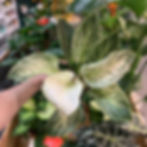How to Look After Philodendron Birkin (Philodendron 'White Wave') - A Care Guide
- Sam Gaunt
- Jan 18, 2022
- 3 min read
Updated: Mar 8, 2022
Here's some tips on how to care for a Philodendron Birkin, so that you can get the best out of this striking variegated house plant.

The White Wave
Sometimes also sold as the Philodendron 'White Wave', the Philodendron Birkin's unmistakable leaves are variegated with a wave of white/yellow stripes.
This evergreen perennial is native to the Brazilian rainforest (which holds around an amazing 489 Philodendron species).
For such a striking plant, it's also rather beginner friendly and will let you know when it's not happy - handy!

Light
A rather versatile choice in terms of light requirements, just be sure not to put your Philodendron Birkin in harsh direct sunlight or a too low-light place, otherwise it enjoys most levels of light exposure.
If this plant isn't getting enough light it may get 'leggy' and grow in the direction of the nearest light source and its leaves will begin to lose their famous white/yellow variegated stripes. If it's in too direct sunlight the leaves may sunburn and get brown patches.
Windowsills that enjoy indirect light, or away from a window in a bright sunny room is usually a good spot for this species of Philodendron.

Soil
As the Birkin likes regular watering but to dry before the next one, a well draining soil that stays moist (but not soaking) for a few days is ideal.
Putting some perlite in your general houseplant soil mix is a great idea to increase drainage and aeriation and reduce compaction. You can also add some wood chips, vermiculite or sphagnum moss to help maintain a little bit of (but not too much) moisture and vary the soil particle sizes for extra drainage and aeration too.

Watering
The Philodendron Birkin is a rather thirsty plant and can be watered as soon as the soil dries out. While it enjoys moist soil it's better to let the soil dry completely before a watering to be on the safe side.
If ever in doubt, pick the pot up each time after watering to get an idea of its weight and do the same a week or so later when the soil should be dry. This way you'll be able to know when it needs a drink.
Overwatering may cause some of the leaves to yellow. If you have yellow leaves and the soil is dry however, it may just be old age and that the leaf is dying off as new foliage grows.

Humidity
Being a tropical plant, the Philodendorn Birkin enjoys some humidity. Feel free to mist the plant occasionally, and don't be afraid to have it in a more humid part of the house or grouped with other humidity loving plants to create their own microclimate.
If the plants leaves are going brown or crispy, the air may be too dry and you might want to try moving the plant to a more humid place.

Temperature
Your Philodendron Birkin prefers temperatures between 18–24°C in the day and is used to slightly colder temperatures (around 16°C) in the evenings. Though it will cope with temperatures a bit outside of this range, it should do fine in average indoor room temperatures.

Toxicity
The Philodendron Birkin is toxic only if ingested - so keep it out of reach of hungry children and curious pets. This is because the plant contains calcium oxalate crystals (like lots of other house plants).

Growth
The Birkin can grow relatively fast if given the energy required for new leaf growth. Fertilizing this plant will help it grow quicker (if you want it to), which you can do around once per month in the growing season (Spring/Summer).
The Philodendron Birkin can grow up to around 3 feet tall when fully matured.